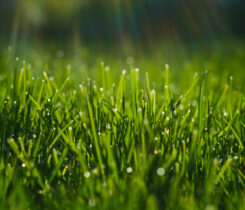Off the Record: The importance of location for warm-season grasses
Scientists have made substantial strides in enhancing the characteristics of warm-season turfgrasses, including drought resistance, winter color, cold tolerance and texture.

Photo: Mike Kenna, Ph. D.
Nonetheless, while there have been advancements in drought tolerance, there remains a lack of comprehensive understanding regarding the irrigation requirements of recently developed cultivars of bermudagrass, zoysiagrass and buffalograss.
This knowledge gap is particularly significant in water-scarce regions, where newer warm-season grass cultivars can help decrease water usage compared to their older counterparts.
The USGA and National Turfgrass Evaluation Program (NTEP) collaborated on a warm-season grass water-use trial at eight U.S. locations from 2019 to 2022 to tackle this issue. This trial had two distinct approaches: one determined water requirements for maintaining quality, while the other assessed grass performance under reduced irrigation ET replacement levels.
The study involved 11 bermudagrass, four zoysiagrass and two buffalograss cultivars, maintained at a standard fairway height of 0.5 inches. The results provide valuable insights for turf managers seeking information on the water needs of specific warm-season turfgrass cultivars across diverse climates and locations.
In the first approach, researchers summarized the daily water needs for each cultivar in the trial to maintain acceptable turf quality, averaged across the four study locations in inches per day.
The commercially available bermudagrass cultivars — TifTuf and Tahoma 31 — consistently outperformed others, demanding the least irrigation for acceptable turf quality at 0.02 inches per day. Tifway was close behind at 0.03 inches and the experimental FB-1628 did well. Monaco and Rio seed varieties averaged 0.04 inches daily across the four locations.
Within zoysiagrass cultivars, the experimental FAES 1306 displayed the lowest water requirement (0.04 inches per day), while the older Meyer had the highest (0.07 inches). Buffalograss cultivars Cody and Prestige generally fell within an intermediate range between the two species.
Bermudagrass cultivars PremierPRO and Dog Tuff exhibited the highest water requirements at 0.08 inches daily. In Florida, five bermudagrass cultivars and one zoysiagrass cultivar did not require irrigation, possibly attributed to local environmental factors and soil characteristics. While in Mississippi, zoysiagrass needed more than double the irrigation compared to most bermudagrass and buffalograss.
In the second approach, researchers conducted trials at four locations with different ET-based irrigation levels in separate sections. Each section received one of three levels, with three replications per ET level. Over four years, the chronic drought treatments were 30, 45 and 60 percent ET replacement, with frequencies adjusted based on location and rain events.
The trial locations assessed turfgrass quality for each cultivar under the three different irrigation levels, grading it on a scale ranging from 1 (poor) to 9 (perfect). Turfgrass performance varied significantly by location, emphasizing the importance of region-specific trials. TifTuf bermudagrass stood out as the top-performing cultivar, maintaining an average quality of 6.5 under the 30 percent ET. Tifway and Tahoma followed closely at 6.0 and 5.8 quality, respectively.
Buffalograss and zoysiagrass did not meet quality standards under the 30 percent ET regime across locations (excluding Florida). In New Mexico, TifTuf, Tahoma and Tifway performed well, while Texas favored Prestige and Cody. Despite a dry season, Florida exhibited acceptable quality for bermudagrass and zoysiagrass for all levels.
Takeaways
This study highlights significant variations in water requirements among warm-season grasses, influenced by genetics, species, cultivar and location factors. When considering a renovation, conducting trials with various species and cultivars can help determine the best performance for your site and maintenance program.












